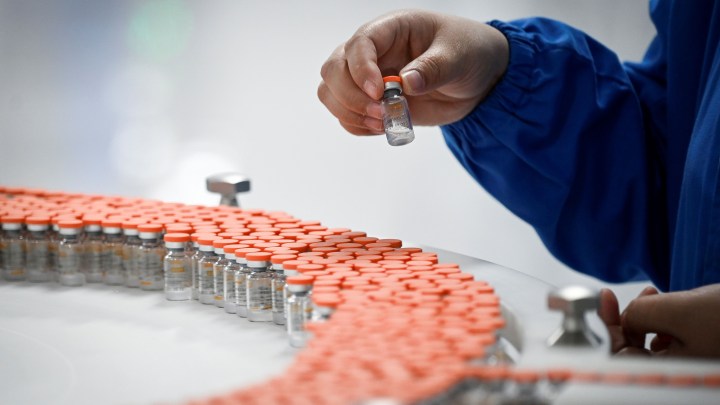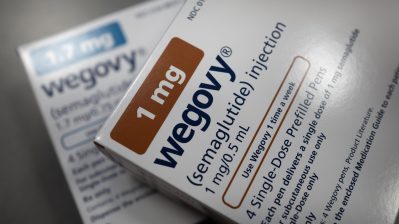
How do we prepare for a COVID vaccine distribution system?
How do we prepare for a COVID vaccine distribution system?

As the race to develop an effective COVID-19 vaccine continues, a number of questions remain over the distribution of it and how to effectively make it available to the rest of the country. Who should get the vaccine first? Will states have all the resources and money they need to run vaccine administration programs? How does the potential of a two-shot vaccine requirement affect distribution?
“Marketplace Morning Report” host David Brancaccio spoke with Dr. Kelly Moore, associate director for immunization education at the Immunization Action Coalition and former director of the Tennessee immunization program, for some insight into how federal and state officials need to think about answering these questions. Below is an edited transcript of their conversation.
Deciding who gets the vaccine when
David Brancaccio: Who is deciding who gets COVID-19 vaccines first, second or third, if and when we get vaccines that work and are safe?
Kelly Moore: The primary group making those recommendations are the federal Advisory Committee on Immunization Practices, or the ACIP. This is a group of external experts. They’re not government employees. They’re experts in the field of vaccines. And they make recommendations to the [Centers for Disease Control and Prevention] about who should get a vaccine and when, and that committee has been in place for 60 years. But then states and local public health will also then be working to take those recommendations and apply them to their local conditions. So we could see slight variations in how these recommendations are implemented based on conditions on the ground, state by state.
Brancaccio: But that document isn’t circulating yet for the public. There’s not a list I can look to see who gets it first?
Moore: The decision has not yet been made by the ACIP because this organization makes their decisions based on evidence. Right now, we don’t yet have evidence on how well our candidate vaccines work or if they work better in one group than another group, or some of the specific pieces of information we must have in order to make evidence-based decisions about who we prioritize first, second and third. The one group that comes up first on everyone’s list, however, are people who work in health care. And this could be an unpaid volunteer. It could be someone who is delivering meals or the doctor or nurse in the ICU. So we all expect those folks to be among the first to receive vaccine.
Brancaccio: But I see the implication of you noting that we need to know more about which vaccines and their characteristics that we’re going to use. Because what if a vaccine works better or worse for let’s say, older people, then that might factor into who gets this earlier rather than later?
Moore: That’s exactly right, David. You have to look and see where the vaccine will yield the greatest benefit. A good example of that is that we know that for the oldest people who are actually most vulnerable to COVID-19 disease — for the oldest people, their immune systems often don’t respond well to vaccination. Even though we vaccinate them every year against flu, we know that it doesn’t work as well in those old immune systems. So when we look at, say, nursing homes, and we do models and computers to see who’s the best group to vaccinate, if you only had 100 doses and 200 people, you should give those hundred doses to the people who work in the facility. And you’d actually save many more lives. And so it’s those kinds of exercises that the ACIP are conducting to make sure that if the supply of vaccine is very limited, we get it to just the right people to save as many lives as possible.
Barriers to distributing a future vaccine
Brancaccio: What needs to be done now, to get the distribution of a vaccine or vaccines organized? It’s my understanding, you think we’re already a bit behind here.
Moore: Well, we’re facing a challenge we’ve never faced before in public health, which is the obvious challenge of vaccines that are not yet licensed. So we don’t yet know all of their characteristics. But there are a few really important things that have my attention. One of them is how resource-intensive this vaccine distribution program is going to be. Right now, the states have been promised, as little as $200 million to be coming their way. It’s not in hand yet for vaccine distribution, planning and response. There’s more money promised by Congress, but nothing is available yet. And this is going to be an intensive program that’s going to last for perhaps a year or longer. So resources are desperately needed. We’ve spent over $10 billion on vaccine development. We can’t afford to get it wrong on getting the vaccine to the people who need it.
Brancaccio: And number two would be on your list?
Moore: The number two issue is the technology requirements. States are going to need to manage a lot of information. Who’s had which vaccine? When did they have it? When is their second dose due? And the federal government wants to and needs to know where [the] vaccine is, how the program is unfolding, have we reached the people who need it most? And if not, what do we need to do to reach them more effectively. And we’re currently planning to build this distribution program, relying on federal systems for reporting and data tracking that aren’t finished being built yet. So the IT infrastructure needed to manage the information flow is still being built. And that’s an issue for the states, because it’s hard to build a program if you’re still waiting for your IT system.
Brancaccio: What do you make of the news the other day that the state of New York is going to review the vaccines itself for safety before it approves any vaccine?
Moore: I don’t know too much about the details of that. But it does concern me that the public isn’t really aware of the roles that we already have in place for people to review carefully these data. Now, I think it is essential that people have access to information to look at for themselves and make well-informed choices for themselves and their families. But the role of the ACIP, and these 14 experts plus a member of the public who dig into the details of these vaccines in great detail, that role has not been communicated to the public I don’t think very effectively. What concerns me a little bit is whether states and other outside groups will have the expertise they need to really interpret the data the same way, a vaccine expert would. On the other hand, we welcome transparency and having as many people as want to look at the information be able to look at the information available on these vaccines.
Making it as easy as possible to administer a future vaccine
Brancaccio: And when we talk about tracking the vaccine, you envision it as this logistical challenge, getting it to where it’s needed. But also, I mean, you want states to carefully keep track of who got the shot. And in some cases, it may be several shots.
Moore: Getting two shots into people of the same brand of vaccine within a month is difficult in the best of circumstances. And especially when you’re trying to have a nationalized, very controlled and targeted program. Actually one of the most important elements in that is ensuring that people have a good customer experience. We don’t think about that too much. But if people have a hard time getting the vaccine, even if they’re eligible for it — if they have to wait a long time, if they have an unpleasant experience with dose one — they may be less inclined to come back for the essential second shot. Because they’re really not protected until after that second dose. And so we’ve got to do a terrific job, not only of informing people and facilitating them coming in for their second dose, but making sure they have a good experience so that the word of mouth encourages people who are eligible to come in rather than discouraging them. It’s a tall order.
Brancaccio: You know, a lot of state budgets are kind of strapped right now, in part because of the economic downturn caused by the pandemic. Are you concerned about money for states that are going to have to administer and track all this?
Moore: States are going to need a lot more resources than they have in hand at the moment. But what we really need, unfortunately, is sustained funding for public health. We’ve often considered public health only when there’s a crisis, and it has been chronically underfunded for decades. If we really want to make sure we’re prepared for the next pandemic and there absolutely will be one, then we need to treat our public health system the same way we treat our military. We need to fund them to be prepared to respond when there’s a crisis and not just fund them at the point of a crisis.
There’s a lot happening in the world. Through it all, Marketplace is here for you.
You rely on Marketplace to break down the world’s events and tell you how it affects you in a fact-based, approachable way. We rely on your financial support to keep making that possible.
Your donation today powers the independent journalism that you rely on. For just $5/month, you can help sustain Marketplace so we can keep reporting on the things that matter to you.


















